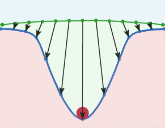
International Mass Loading Service: Tidal Ocean Loading
The Earth as a whole responses to external forces as an elastic body
while the ocean response far from the shore takes the shape of
equipotential surface. For this reason we observe ocean tides: relative
redistribution of ocean with respect to the lithosphere. Due to viscosity
response the ocean response deviates from the equipotential surface,
especially in shallow seas. Ocean mass re-distribution due to tides
causes crustal deformation called ocean tidal loading.
Tides can be represented as a sum of quasi-harmonic constituents that
are characterized by frequency, angular acceleration, phase, sine, and
cosine amplitudes. The last three parameters depend on site coordinates.
Tidal constituents consist of short-periodic tides with frequencies
around the diurnal frequency and its harmonics, long-periodic (or zonal)
with periods from 18.6 years to 5 days, and several pole tide constituents.
The pole tide is caused by changes in the centrifugal potential due
to polar motion. Other tides are caused by gravitational attraction of
the Moon and the Sun. The vertical displacements typically have
peak to peak variations around 1 cm, although there are areas where they
can be as large as 10 cm.
On 2014.06.17 the service of tidal atmospheric pressure loading
was established by Leonid Petrov. The service is based on the spherical
harmonics transform of the bottom pressure exerted by the ocean tide
according to several tidal models. In general, tides are split into
- gravity tides described by the tidal model that are based
on assimilation of satellite altimeter data and the underlying
numerical model that is a result of solving hydrodynamics equations.
Gravity tides consist of a number of quasi-harmonics constituents:
A_c cos ( P + Ω t + 1/2 α t2 ) +
A_s sin ( P + Ω t + 1/2 α t2 )
where α is the angular acceleration.
- long periodic tides described by the so-called equilibrium
tidal model that assumes ocean water for these constituents follows
the equipotential surface with correction for total ocean mass
conservation and self-loading, i.e. considering crustal deformation
of the ocean bottom. Deviation of long-periodic tides from
the equilibrium is not large. Some gravity tides model include several
(but not all) long periodic models.
- pole tides described by the equilibrium tidal response and
a harmonic model of polar motion. Pole motion and therefore, changes
in the centrifugal potential over [1984, 2014] are approximated as
a sum of three harmonic component with periods 365.24 days (annual),
431.18 days, and 445.41 days (Chandler period) with rms of residuals
0.029 mas. Therefore, pole tides can be considered using the same
formalism as gravity tides.
The service provides
- Precomputed coefficients
of harmonic variations of 3D displacements
4341
VLBI, GPS, SLR, and DORIS
stations. Displacements are in
HARPOS format.
- Precomputed coefficients of harmonic
variations of 3D displacements
of ocean tidal loading at a 2′ × 2′ global grid.
Displacements are in
NETCDF format.
- Site
displacements: 17 gravity tides according to GOT 4.10c model
for gravity tides.
- Site
displacements: 44 gravity tides according to FES2014b model
for gravity tides, including 7 long period tide.
- Site
displacements: 3 pole tides and 1 long-periodic gravity tide
according to the equilibrium tide.
- Site
displacements: 3 pole tides and 9 long-periodic gravity tide
according to the equilibrium tide.
- On-demand online computation of tidal
ocean loading for an arbitrary point at the Earth.
You can order computation of the time series for the stations of
your interest. You need to prepare a station file in plain ascii that
has four columns separated by one or more blanks:
Station_name
X-coordinate Y-coordinate Z-coordinate
Station name should have no more than 8 characters. X,Y,Z are Cartesian
coordinates of the station of interest in a crust-fixed coordinates system.
Units are meters. Here is an example.
Results of on-demand computations
are accessible from here.
References
-
Darwin, G.H., On variations in the
vertical due to elasticity of the Earth's surface,
Phil. Mag., Ser. 5, col. 14, N. 90, 409--427, 1882.
-
Farrell, W.E, Deformation of the Earth by Surface Loads,
Rev. Geophys. and Spac. Phys., vol. 10(3), pp. 751--797, 1972.
Acknowledgment
This work was supported by NASA
Earth Surface & Interior program, grant NNX12AQ29G.
Back to the International Mass Loading Service.
This page was prepared by Leonid Petrov
( )
)
Last update: 2021.07.19_08:01:58